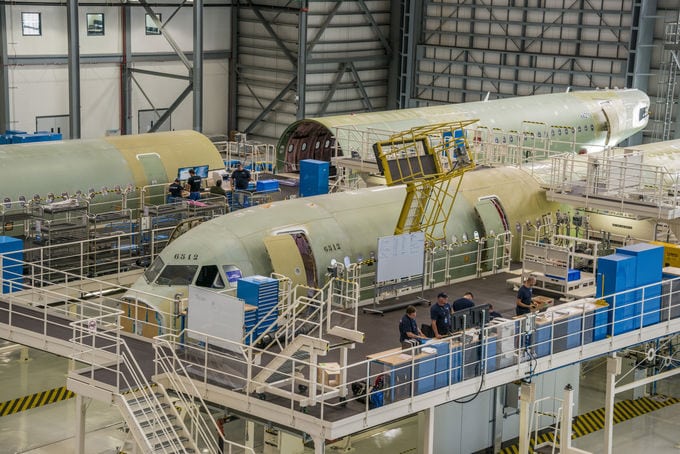[Avionics Today 09-22-2015] Airbus inaugurated operations at is first U.S. manufacturing facility in Mobile, Ala. last week in a move that is likely to strengthen the company both financially and competitively. The move to North America reflects the company’s desire to bolster U.S. relations with both commercial and government markets.
 |
| Airbus’ Mobile, Ala. facility. Photo: Airbus |
At the new facility’s inauguration ceremony, Airbus President and CEO Fabrice Bregier noted that the $600 million plant was the latest in the company’s string of European and Chinese facilities in a move to “strategically expand [Airbus’] worldwide industrial base.” Expansion can help not only relieve some of the ramp-up issues facing European facilities as the demand for aircraft skyrockets, but also boost local relationships, according to Christophe Benaroya, director of the aerospace MBA program at the Toulouse Business School.
“Being close to the customer and world markets implies a global presence, not only commercially but with manufacturing, services and employment, which offer more ‘local content,’ meaning local jobs and economic activity. It is clearly an advantage to have the ‘Made in America’ label for American customers, whereas Chinese ones appreciate ‘Made in China,’ etc.,” said Benaroya. “A manufacturing presence in a country or on a given continent brings local markets closer in an authentic way. It underlines the keen corporate interest to engage with local communities for creating quality jobs and long-term, stable relationships.”
Moreover, manufacturing on U.S. soil, with a “real and visible” U.S. footprint, will make the company even more accepted for U.S. civil and military bids, according to Benaroya, who also notes that the manufacturer is contemplating a version of the A400M Atlas, a turboprop military transport aircraft, for the U.S. market, as well as solutions for safety and security, and coast guards, among others.
The new facility will also enable Airbus to boost its presence in America beyond civil aircraft, including entering into the helicopter and space arenas. But most importantly, it may reinforce the company as a possible prime contractor for the U.S. Department of Defense (DOD).
“Airbus is manufacturing on American soil with a strong motivation to extend the present workforce, especially as the existing facilities are running at a quarter of its possible capacity. This shall lead to more credibility for Airbus as a long-term partner, as well as a possible DOD contractor with possible production on American soil,” said Benaroya. “It also makes all administrative burdens imposed by U.S. regulations on exporting technologies, such as [International Traffic in Arms Regulations] ITAR, much easier.”
Outside of improved relations, an expanded global footprint also minimizes the impact of currency fluctuations in the market on Airbus’ bottom line. According to Cordula Barzantny, associate dean of aerospace business development and projects at the Toulouse Business School, while Airbus has previously absorbed a certain amount of the impact on its Profit and Loss (P&L) statements due to the difference between euros and the U.S. dollar — European workers, parts and systems are paid in euros whereas sales are denominated in U.S. dollars — the global nature of the company is likely to minimize currency risk in America.
“The volatility of the euro-U.S. dollar exchange rate has had an immediate impact on the Airbus Group’s accounts,” Barzantny said. “Whenever the U.S. Dollar floats, their results are affected by exchange rates independently from the industrial performance of the business. In order to limit bad surprises, companies buy financial insurance in order to limit the possible losses due to currency exchanges, known as hedging, which certainly limits some risks, but also has a cost.”
With the new facility, both manufacturing costs and incoming sales are made in the same currency, so there’s no need to hedge the currency risk. “The more the Airbus Group manufactures and spends in U.S. dollars, the less the currency fluctuations will affect corporate results,” Barzantny added.
While only a quarter of the plant is occupied today, the facility will likely increase operations to full capacity in coming years, producing between 40 and 50 single-aisle aircraft per year by 2018, according to Airbus’ plans. With the company’s latest market forecast predicting demand for some 4,700 single-aisle aircraft in North America over the next 20 years, Airbus will seek to address this need by producing the A321 aircraft in this new facility.
“The American market is the most mature aircraft market in the world with a large number of older aircraft, which will need thousands of units replaced soon. Therefore, the single-aisle A320 short/mid-range aircraft has an ideal positioning in this replacement market, particularly with the point-to-point routes,” said Benaroya. Furthermore, while the needs of other segments, such as the twin-aisle market, are already provided by existing European assembly lines, Airbus’ main single-aisle production site in Hamburg, Germany has faced growth limitations due to its urban location, Benaroya added. With Hamburg facilities running at their highest possible capacity, the Mobile, Ala. facility will offer some relief for single-aisle aircraft production.
The first U.S.-made commercial aircraft is scheduled for delivery in Spring 2016. Going forward, it’s likely Airbus will continue its global expansion to bolster relations, relieve capacity constraints, and continue to increase its footprint, according to Benaroya.
“There is certainly still some room for a ‘Made in India’ project in the future,” he said.